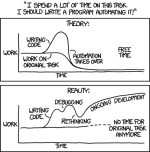defcon.klaxon
Lifetime Supporting Member
As a newcomer to RSLogix, I keep reading about (and am quite interested in) how companies automate tagname creation and have libraries of predefined code that makes code generation much more automated than manual, from-scratch programming. I have read posts where coders claims that up to 80% of their code is predefined, and only 20% maximum is manually coded. All I can say is, wow! Right now I'm very deep in my water treatment plant project that many of you might remember if you recognize my username. Every line of code has been manually programmed by me, but what I understand is that many companies automate a lot of this process since RSLogix files can be interpreted as plaintext and a lot of the drudgery I've manually taken care of can be automated and reduce workload and obviously this is quite interesting.
I realize that a lot of the specifics are going to be covered by NDAs and that specific info can't be shared, but I was wondering if any suggestions can be shared on how a company might approach this method, and just how much can truly be automated. From my perspective, trying to code with enough generic options, yet be solid code, would be very difficult just from the perspective of how many possibilities are out there for how to tackle a problem and the specific requirements of each individual project. Yet, I can see how once you overcome the "generic code can meet specific requirements" hurdle, how development can be sped up quite a lot.
So I guess my question is, how do I approach the challenge of creating pre-defined code libraries that are general enough to fit multiple applications, but are flexible enough to meet specific requirements without requiring total rewrite during every project? Secondarily, how does one approach that design concept, and determine how to automate the process? Is it custom Python code at every company? Are there commercial solutions available?
I realize that a lot of the specifics are going to be covered by NDAs and that specific info can't be shared, but I was wondering if any suggestions can be shared on how a company might approach this method, and just how much can truly be automated. From my perspective, trying to code with enough generic options, yet be solid code, would be very difficult just from the perspective of how many possibilities are out there for how to tackle a problem and the specific requirements of each individual project. Yet, I can see how once you overcome the "generic code can meet specific requirements" hurdle, how development can be sped up quite a lot.
So I guess my question is, how do I approach the challenge of creating pre-defined code libraries that are general enough to fit multiple applications, but are flexible enough to meet specific requirements without requiring total rewrite during every project? Secondarily, how does one approach that design concept, and determine how to automate the process? Is it custom Python code at every company? Are there commercial solutions available?







